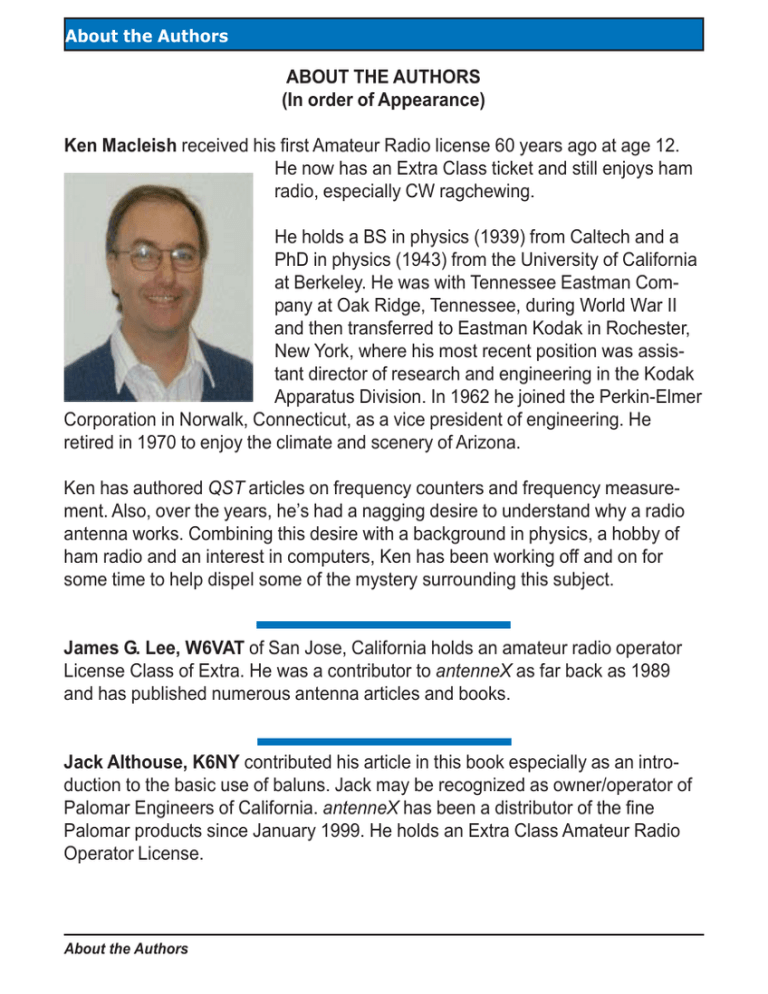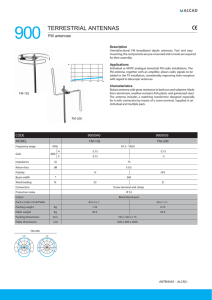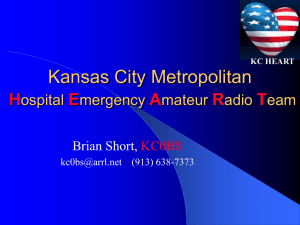Authors - antenneX
advertisement

About the Authors Feeding Antennas Page 7 ABOUT THE AUTHORS (In order of Appearance) Ken Macleish received his first Amateur Radio license 60 years ago at age 12. He now has an Extra Class ticket and still enjoys ham radio, especially CW ragchewing. He holds a BS in physics (1939) from Caltech and a PhD in physics (1943) from the University of California at Berkeley. He was with Tennessee Eastman Company at Oak Ridge, Tennessee, during World War II and then transferred to Eastman Kodak in Rochester, New York, where his most recent position was assistant director of research and engineering in the Kodak Apparatus Division. In 1962 he joined the Perkin-Elmer Corporation in Norwalk, Connecticut, as a vice president of engineering. He retired in 1970 to enjoy the climate and scenery of Arizona. Ken has authored QST articles on frequency counters and frequency measurement. Also, over the years, he’s had a nagging desire to understand why a radio antenna works. Combining this desire with a background in physics, a hobby of ham radio and an interest in computers, Ken has been working off and on for some time to help dispel some of the mystery surrounding this subject. James G. Lee, W6VAT of San Jose, California holds an amateur radio operator License Class of Extra. He was a contributor to antenneX as far back as 1989 and has published numerous antenna articles and books. Jack Althouse, K6NY contributed his article in this book especially as an introduction to the basic use of baluns. Jack may be recognized as owner/operator of Palomar Engineers of California. antenneX has been a distributor of the fine Palomar products since January 1999. He holds an Extra Class Amateur Radio Operator License. About the Authors Feeding Antennas Page 8 L. B. Cebik, W4RNL, has written extensively about antennas and antenna modeling (as well as other electronics subjects) in most of the U.S. ham journals, including QST, CQ, Communications Quarterly, QEX, Ham Radio, 73, QRP Quarterly, Radio-Electronics, and QRPp. Besides the continuing series of antenna modeling columns he does for antenneX, he also writes a column for 10-10 News (AnTen-Ten-nas) and another for Low Down (Antennas From the Ground Up). A life member of ARRL, he serves as both Technical and Educational Advisor. Several years ago, LB joined the position as Technical Editor for antenneX. L. B. has published over a dozen books, with works on antennas for both the beginner and the advanced student. Among his books are a basic tutorial in the use of NEC antenna modeling software and compilations of his many shorter pieces. 18 of his books have been published by antenneX and listed in the BookShelf at our website. He has been a ham since 1954 and is also a life member of QCWA and of 10-10 International, for which he maintains an extensive web site. He also maintains a web site of his own ( http://www.cebik.com ) on which he has placed a large collection of entries from his notebooks. A teacher for over 30 years, he is retired and professor emeritus of philosophy at the University of Tennessee, Knoxville. antenneX is very fortunate, indeed, to have LB as a member of its writing team and Tech Editor. William R. Booher, W6TM is another contributor to antenneX dating back to 1988. William holds an amateur radio operator license of Extra. He resides in Laguna Hills, California. About the Authors Feeding Antennas Page 9 RICHARD MORROW, K5CNF has an Associate Degree In Electronic Engineering, attended many classes and seminars conducted by Motorola, RCA, General Electric, Furuno. Has been a licensed radio amateur since September 1955 and holds an Advanced Class. Held license as a 2nd Class Commercial Radio Telephone operator w/shipboard Radar endorsement since 1957, upgraded to 1st Class radiotelephone operator in 1960. Has been a broadcast engineer for AM, FM and TV. Was a electronics instructor for United Electronic Institute in Dallas, Texas, Over 100 published articles in 73 Amateur Radio, Radioscan, and of course, antenneX where he has been an associate since its creation in 1988. Spent three years as a radio operator (1962-1965) in the US Army, assigned to Headquarters Company, 1st Battalion, 23rd Infantry, 2nd Inf. Div., Ft. Benning, Georgia. Worked in two-way radio industry as field technician for years. Previous jobs include Texas Instruments, Collins, Dresser Atlas, S.W. Bell Telephone, and several broadcast stations as chief engineer. Has three patents issued on electronic devices and is an eternal experimenter. Built many transmitters, amplifiers, and numerous other ham devices as needed. Work DX when it shows up. Best DX, Pitcarin Island on 10 meters with the HTX100 and a converted Cushcraft 1/2 wave CB vertical propped up against the garage. Other DX includes ZL on 75 meter SSB with 60 watts, Senegal on 75 meters SSB, 60 watts again, antenna was a dipole at 35 ft. Current activity is on 160 meters sometimes, 40 meters, two meters and 440 MHz. Favorite antennas are: Phased arrays, magnetic antennas, directional arrays, and anything that radiates well. Current rigs are TS-430S, TS-700 multi-mode, Kenwood two FM meter rig, Icom 440 ht. Radio Shack HTX-100, Radio Shack 440 ht, 2 Atlas 210x, Johnson 275 watt Matchbox, Johnson Thunderbolt, several older SGC SSB marine rigs, three Heathkits. Interests include; antennas, astronomy, music, both radio and optical, reading, photography, motorcycles, archeology, cars, Cosmology, Science in general, Nature, animals and aviation. About the Authors Feeding Antennas Page 10 Kevin Schmidt, W9CF is a physics professor at Arizona State University in Tempe and a fellow of the American Physical Society. He primarily does research on quantum many-particle simulations using and developing Monte Carlo techniques. Kevin spends part of most summers at the Scuola Internazionale Superiore di Studi Avanzati (SISSA) in Trieste. First licensed as WA9THN in 1966 changing to W9CF in 1977, Kevin enjoys casual contesting, occasional ragchews, and working on boat anchor equipment. Jef Verborgt, PhD was born in 1944 in Belgium. Jef was saved from a certain early death by meningitis by the American soldiers having the first penicillin for which he is still grateful. He went on to obtain a Ph.D. degree in Polymer Chemistry in 1970 at Louvain Belgium followed by a postdoctoral Fellowship with Dr. C.S. Marvel at the University of Tucson, Arizona. Jef has been Director of Research for Sigma Coatings for 15 years after which he became Director of the International Business Operations for Marine and Protective Coatings. Jef further held the position as President of Sigma Coatings USA in New Orleans, Louisiana. He is married to Marijke from Holland where Jef had lived for some 20 years. He is the father of one daughter and two grandchildren who live in Belgium. Jef says he enjoys fishing, Louisiana food, experimenting with antennas and living in the USA. About the Authors Feeding Antennas Page 11 Tom Cox, KT9OM, is assistant director of the information technology department of a 10,000-student, 7,000-computer public school corporation. His most recent project is replacing the corporation’s leased digital telephone lines with high-speed wireless connections. On his own time, Tom plays with antennas, reads fiction and non-fiction, and gardens or removes snow and splits firewood, depending on the season, and rides about 250 miles a summer on a bicycle. He was born to generous and patient parents, Jim and Jeannette Cox (both deceased), in 1949, and has been a Ham since 1982. He shares his Muncie, Indiana home with his lovely and indulgent wife, Sherry, and three dogs. He shares his neighborhood with his brother, KA9PBO, with whom he plays radio and attends hamfests. Tom is an active member of the GARDS. Fred M. Griffee, N4FG (EE Ret) After graduating from the Orono, Maine High School, I joined the Navy for a three-year tour to get my service requirements completed. I was extended one year due to the Korean situation near the end of my three-year tour of duty. My service time was then nearly four years or from 1948 to 1952. I served as a Radio Operator for the Navy during the entire tour of duty. After leaving the Navy, I went back to school at the University of Maine and received an engineering degree in Electrical Engineering in 1956, with a minor in power distribution and mathematics. From that point on, I worked with various companies as electronics engineer, specializing in navigational aids, communications, and computer systems at various levels of responsibility until retiring in 1988. About the Authors Feeding Antennas Page 12 My amateur radio interests started in 1945 and I got my first license in 1948 as W1QWV. At that time, the FCC required issuance of a new call sign when moving to new districts. So I received K2UUU when moving to New Jersey in 1956, and then W4IYB when moving to Virginia in 1965. My present call was issued to me after application in 1968. My interests in amateur radio have been experimental projects but more specifically in the antenna and transmission systems. However, I did design and build a complete amateur radio station in 1967, which was a very interesting project, especially regarding the receiver and transmitter. To date, my interests are still primarily antenna systems, which include antenna tuners (impedance matching networks), antennas, and transmission line characteristics. My primary amateur radio mode of interest is still CW. Jan Gunmar, SM0AQW was born at Uppsala, Sweden in 1930. Obtained a MS degree from Stockholm Polytech (KTH) in 1955. Master thesis: synthesis of 90 degree phasing networks. A short-wave radio Ham since 1948 with calls SM5AQW and SM0AQW – main ham interests are rag chewing, contesting and DXing, prefers CW and digimodes. Main career was at Ericsson at various positions in design, project management and line management in the areas of mobile telephony, high power microwave transmitters, avionics and satellite electronics – one proud achievement was serving as Project Manager for a subcontract involving flight hardware for the Hubble Space Telescope. Retired 1995 as Divisional QA Manager from the Airborne Electronics Division of Ericsson Radar Electronics in Stockholm. Hobbies and interests besides radio: music, both jazz and classical – plays the bass trombone, guitar and violin, arranges music – gardening and science history. Jan is married to Britta and the couple has two grown-up children. About the Authors Feeding Antennas Page 13 Dudley Chapman holds a BA in Physics from the State University of New York and an ASEE from Thames Valley State Technical College. His engineering career spans radio and television broadcasting, scientific instrumentation, and software development. He has held engineering management positions in well-known companies, including Millipore and Bell & Howell. In 2002, Dudley started his own software development company, Native Logic Inc, which develops enterprise level software systems for specialized vertical markets. Dudley’s interest in antennas started at age seven when his grandfather gave him a pocket crystal radio with two alligator clip leads for antenna and ground. That gift led to countless hours of clipping to metal objects looking for good antennas. Through his teenage years the interest expanded to FM, VHF and UHF TV DXing and finally to being licensed as WN1FWA in 1966. Dudley developed an interest in antenna modeling early on when he had access to NEC2 running on a VAX mainframe. Dudley has held First Class FCC Radiotelephone license and is now licensed as WA1X. The journey has come full circle as Dudley is now interested in antennas for low power DXing on 160 meters. About the Authors



![EEE 443 Antennas for Wireless Communications (3) [S]](http://s3.studylib.net/store/data/008888255_1-6e942a081653d05c33fa53deefb4441a-300x300.png)